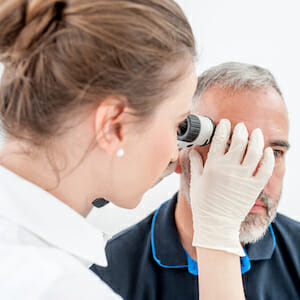The Importance of An Annual Skin Cancer Check
- Posted on: May 17 2021

Skin cancer is the most prevalent type of cancer in the United States, with more than one in five Americans developing the disease by the time they’re 70. May is Skin Cancer Awareness Month, and there’s no better time to schedule your annual skin cancer screening at Asarch Dermatology. Our board-certified dermatologists offer complete skin checks and encourage our patients to regularly examine their skin at home.
Skin Cancer Types and Causes
Most skin cancer types are caused by frequent exposure to sunlight. The sun’s ultraviolet rays damage DNA in the skin, resulting in the abnormal growth of skin cells. Skin cancer also occurs from the artificial ultraviolet light in tanning beds. Areas of skin that are often exposed to the sun, such as your head, face, neck, and arms, are common parts of the body for skin cancer to develop.
The three types of skin cancer are basal cell carcinoma, squamous cell carcinoma, and melanoma. Although it’s less common than basal cell carcinoma and squamous cell carcinoma, melanoma is considered the most serious due to its ability to spread rapidly throughout the body.
Why Are Annual Skin Checks Important?
Annual skin exams from your dermatologist at Asarch Dermatology and performing regular skin exams at home are the best way to catch the early warning signs of skin cancer, a discovery that can be lifesaving. Early detection is essential to successful skin cancer treatment and can help prevent cancer from spreading to other parts of the body. When caught early, the 5-year survival rate of melanoma is 99%.
How Often Should I Get a Skin Cancer Check?
Wondering how often skin cancer check should be performed? The Skin Cancer Foundation recommends that all adults receive a complete skin check once a year from their dermatologist. Screenings are especially important for those of us living in Denver since the city is a mile higher than sea level. According to the University of Denver, residents of Denver are exposed to about 26% more UV radiation due to the higher altitude.
If you’re at a higher risk of developing skin cancer, you should receive a screen check more often than once a year. These risk factors include having a history of tanning, sunburns, and previous skin cancer diagnosis.
What to Look For When Examining Your Skin At Home
The Skin Cancer Foundation recommends carefully examining your skin from head-to-toe approximately once a month. Not all skin cancer types will look the same, and they can appear in several shapes and sizes. Here are several things to look for when examining your skin at home:
• A mole or spot that’s new or different from any others
• A spot that changes in shape, size, or color
• A sore that bleeds, itches, hurts, crusts, or scabs
• A wart-like growth
• Any rough or scaly red patches
• A spot or mole that is bigger than a pencil eraser
• A black or brown streak under a nail
• A spot that appears red, black, blue, tan, pearly, or transparent
• A mole or spot with an irregular border or asymmetrical shape
Call our office to schedule an appointment or request an appointment online if you notice any of these skin cancer symptoms.
What to Expect During a Skin Cancer Screening
Most screenings take about 15 minutes. During your skin cancer screening, you’ll remove your clothing and wear a medical exam gown. Your board-certified dermatologist will thoroughly examine your skin from head to toe, including hard-to-see places like your scalp, buttocks, ears, the soles of your feet, and between your toes. The dermatologist may use a small magnification tool or bright light to look at your skin in more detail.
If your dermatologist notices anything suspicious, the doctor will perform a skin biopsy by removing a small amount of tissue so it can be closely examined under a microscope. Skin cancer treatment depends on the type and stage of cancer.
To help prepare for your screening, we recommend removing anything that covers your skin, including makeup, nail polish, bandages, and jewelry. You’ll also want to make note of any suspicious moles or spots you discovered during your self-exam that you want to show to your dermatologist. Feel free to ask your dermatologist any questions about skin cancer or tips on how to examine your skin at home.
Can You Prevent Skin Cancer?
Many cases of skin cancer can be prevented. Follow these tips to reduce your risk:
• Wear a broad-spectrum sunscreen with an SPF of 30 or higher. The Asarch online store features several products that protect your skin from the sun, including SkinMedica Essential Defense Everyday Clear Broad Spectrum SPF 47, SkinMedica Essential Defense Mineral Shield Broad Spectrum SPF 32 (Tinted), SkinMedica Essential Defense Mineral Shield Broad Spectrum SPF 35, SkinMedica Total Defense + Repair Broad Spectrum Sunscreen SPF 34, and SkinMedica Total Defense + Repair Broad Spectrum Sunscreen SPF 34 (Tinted)
• Avoid tanning beds.
• Don’t get sunburned.
• Wear long-sleeved shirts, pants, or a wide-brimmed hat to cover exposed skin.
• Seek shade as much as possible during the hours of 10 am to 4 pm.
• Wear sunglasses.
• Wear lip balm with sunscreen.
• Examine your skin every month for skin cancer symptoms.
• See your dermatologist once a year.
Schedule Your Annual Screening
Call Asarch Dermatology today to schedule your annual skin check or request an appointment online. Our board-certified dermatologists are trained in detecting skin cancer and will perform a complete visual exam to ensure the health of your skin.
Posted in: Blog Post, Skin Cancer, Skin Care
